RH-A30
back to Roland
back to measurements
home
published: Nov-22-2023
NO SMOOTHING is applied to the shown plots. Most measurement sites have some smoothing applied which ‘irons flat’ sharp peaks and ‘wiggles’. I do not use smoothing because some info about sound quality is lost when plots are smoothed.
Aside from a small correction of the microphone itself also some correction in the lowest frequencies is applied to the plots to compensate for the perceived loss of bass when using headphones. This is described HERE in more detail.
A ‘horizontal‘ frequency response curve on the shown frequency response plots on this website thus indicates a perceived ‘flat’ tonal signature.
ALL measurements are made with a good SEAL on a flatbed measurement rig.
The shape of your head, bone structure, pad size, pad ‘softness, (compliance), hair or no hair and or wearing glasses may (drastically) change the frequency response of some headphones, so… your personal experience may differ substantially from these plots.
Frequency response (tonal balance) is the most sound-determining aspect of headphones. A horizontal line shows audible neutral response in the plots on this website. Deviations in different severity at different frequency bands have an effect on the sound character.
The bigger the deviation the stronger the effect.
Below an aid to help determining the sound character of headphones with relation to the frequency response.

Roland RH-A30
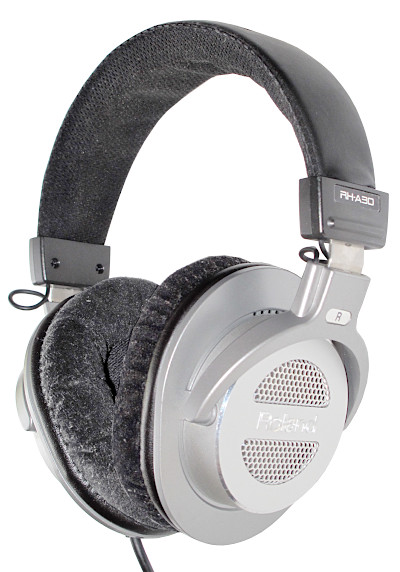
The Roland RH-A30 is not a well known headphone in the Hi-Fi scene. The RH-A30 is targeted at home recording and musicians. It has been in production from at least 2007 and is still being sold today (Nov. 2023). It costs around € 160.-
There is also a closed version called the RH-300.
The RH-A30 is quite sturdy and looks nice. The headband is cloth covered and padded with soft foam. Height can be adjusted over 35mm so will fit larger heads as well.
The clamping force is excellent, not too tight, not too loose (2.5N) so a good seal is possible and the headphone will stay in place when moving around a bit.
The cups can be rotated over almost 360 degrees. Swivel is small, about 10 degrees but sufficient.
The pads are velour on top of regular foam and replaceable. Room for the ears, alas, is not that big.
The inner height is just 50mm so chances are some ears will not completely fit in there.
Also the width of the pads is on the small side with just 36mm.
The depth is just 14mm so chances are your outer ear will be touching the dust-guard netting of the pads. The driver sits just a few mm deeper.
As this is an open headphone there is no isolation from outside noises and people around you can hear it when music is playing.
The cable is very long (3.5 meters) and has a 3.5mm threaded and gold-plated TRS jack with a screw-on 6.3mm adapter. Plugs look nice and sturdy. The cable is supple, feels nice and sturdy and just mildly microphonic. Touching the cable is just barely audible in the left cup.
There is a 45mm driver with an impedance of 42Ω. It has a quite high sensitivity (116dB/V) and efficiency (102dB/mW) so plays quite loud from portable gear. The driver can handle a staggering 1.6W so will be hard to destroy with most amps.
specifications:
Type: Over-ear (circum-aural), open
Usage: Home, Studio
Isolation: close to none
Driver type: dynamic
Pads: replaceable, velour, regular foam.
Inner pad dimensions: Height: 50mm, width: 36 mm, depth: 14mm (oval shape)
Collapsible: no
Headphone connector: fixed
Cable entry: left sided.
Cable: 3.5m terminated in 3.5mm (threaded) 3.5mm TRS plug with screw-on 6.3mm adapter
Driver size: ø 45mm, angled 6°
Nom. power rating: 1.6W
Max. voltage: 8.2V (23Vpp)
Max. current: 190mA
Max. S.P.L.: 133dB
Impedance: 42Ω
Efficiency: 102dB @ 1mW
Sensitivity: 116dB @ 1V
Weight: 240 g. (excl. cord)
Color: Silver with black pads and headband
Clamping force: medium/low (2.5N)
Accessories: 6.3mm adapter, pouch
Sound description:
This headphone can be used quite well for Hi-Fi listening and is surprisingly neutral.
Bass quality is quite good. Sub-bass (deepest movie rumbles) is a bit low in level but bass is at the proper level.
Mids are realistic, not overly dynamic nor compressed. Clarity is a mixed bag and is lacking a bit for music enjoyment. Those looking for beautifully rendered nuances in music may be left wanting a bit more.
There is sharpness in the treble and a bit of a ‘hard edge’ to some instruments.
There is no sibilance (ssss sounds being exaggerated).
Treble is not ‘smooth’ but present but not of great quality.
It needs to be pointed out that this headphone is a headphone that is to be used as a monitor headphone and one could even check mixes on these and tonal balance for this is quite decent.
measurements
Below the frequency response of the Roland RH-A30 (Right, Left)  The bass extension and linearity is excellent from <10Hz to 1kHz with a slight emphasis on the lows. Above 1kHz it doesn’t look as nice anymore. The 3.5kHz ‘dip’ is responsible for the lack of presence/clarity. This dip is wider and deeper than with most other headphones I measured. The treble from 9kHz to 18kHz is not elevated and at the proper level. The fact that above 4kHz the treble has lots of peaks and dips usually is an indicator of diminished resolution in the treble. The frequency response shown above has a high correlation to how it sounds.
The bass extension and linearity is excellent from <10Hz to 1kHz with a slight emphasis on the lows. Above 1kHz it doesn’t look as nice anymore. The 3.5kHz ‘dip’ is responsible for the lack of presence/clarity. This dip is wider and deeper than with most other headphones I measured. The treble from 9kHz to 18kHz is not elevated and at the proper level. The fact that above 4kHz the treble has lots of peaks and dips usually is an indicator of diminished resolution in the treble. The frequency response shown above has a high correlation to how it sounds.
The headphone is specified from 10Hz to 25kHz which seems accurate when specified at -10dB.
-10dB is about a halving of perceived loudness.
compared to
Below (alternating) the RH-A30 compared to the (closed) RH-300 and RH-5 and some other well known open headphones.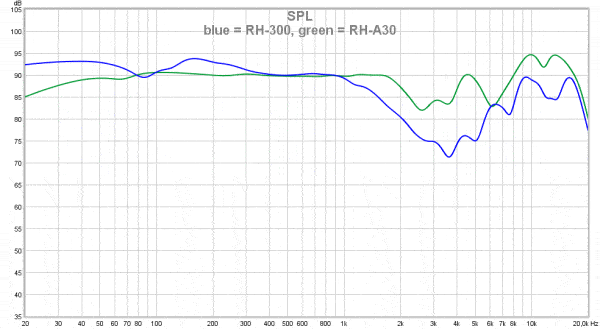 Tonality of this headphone is very similar to known ‘neutral’ headphones.
Tonality of this headphone is very similar to known ‘neutral’ headphones.
Phase response
Below the phase response of the RH-A30 (left, right) 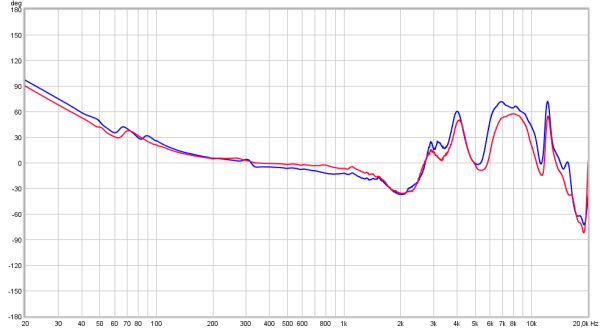 Gentle sloping phase is not audible. Above 4kHz the phase changing within a narrow frequency band and is potentially audible.
Gentle sloping phase is not audible. Above 4kHz the phase changing within a narrow frequency band and is potentially audible.
output resistance / damping-factor
As this is a dynamic headphone the frequency response can be amplifier output resistance dependent when certain higher output resistance amplifiers are used.
Instead of showing impedance plots, which are hard to ‘read’ when it comes to assessing the tonal balance change in the real world, the RH-A30 is measured via a few different resistance outputs (0.2Ω, 10Ω, 33Ω and 120Ω). On a higher output resistance amplifier the output level will be lower of course due to voltage division. To compensate for this the amplifier is cranked up to the same level (11.6dB for 120Ω at 1kHz in this case). This way the plots are overlaid and it is easier to see how the tonal balance changes. Output resistances between the mentioned resistance values will result in tonal changes between those traces.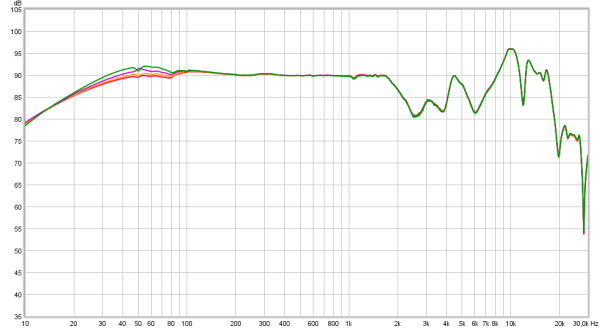
The resonance frequency of the used driver is very low (50Hz) and fairly well damped. There is just a slight tonal change on higher output resistance amplifiers. Fortunately the change is small and even positive as there is +1dB of low-bass.
seal
Seal can be an issue with closed-back headphones but is usually less of a problem for open headphones. Breaking the seal (improper fit on the head) usually means a loss of (sub)bass.
Perfect seal, seal broken with a thick arm pair of glasses with the arms resting against the skin, seal broken with thick armed glasses not resting against the skin and seal substantially broken by slightly lifting the bottom of the pads which can occur when not properly seated.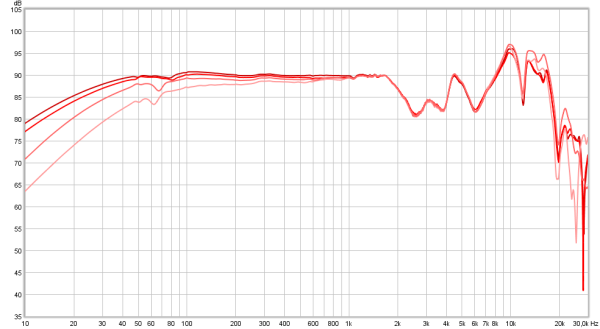 The RH-A30 is not entirely insensitive to a seal breach. People wearing glasses will not experience a loss of bass unless the seal is substantially broken.
The RH-A30 is not entirely insensitive to a seal breach. People wearing glasses will not experience a loss of bass unless the seal is substantially broken.
Below the distortion plot of the left channel. 
The plot above is in a dB scale, below the same measurement but in a percentage scale.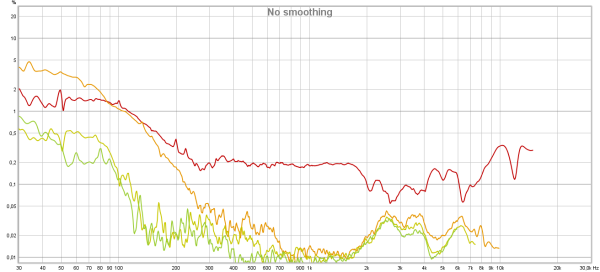
The distortion between 30Hz and 100Hz is a bit on the high side. The increased harmonics below 100Hz is indicative of compression (very soft clipping).
NOTE: The actual 2nd harmonic distortion above 200Hz may well be much lower than 0.2%.
A shortcoming (measurement limit) of my test fixture.
linearity / compression
The test below is the headphone measure 4 times but at 70dB, 80dB, 90dB and 100dB SPL. These traces are then overlaid. When there is compression (drivers not being able to react linear to the applied voltage) this is shown by the frequency response dropping near the lower frequencies.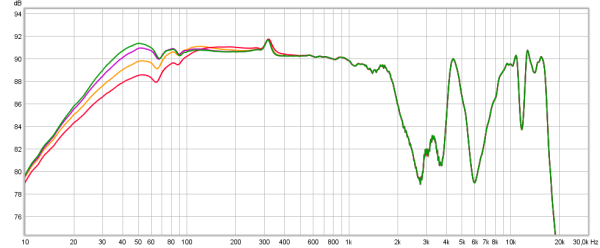 Note the 2dB/div scale. The driver starts to use linearity in the bass region (where the amplitude is the biggest) the compression starts to occur from 75dB SPL which is already pretty quick. One should realize that 75dB SPL around 40Hz is about 60dBA which is not loud at all.
Note the 2dB/div scale. The driver starts to use linearity in the bass region (where the amplitude is the biggest) the compression starts to occur from 75dB SPL which is already pretty quick. One should realize that 75dB SPL around 40Hz is about 60dBA which is not loud at all.
40Hz at 100dB SPL is reproduced about 2dB lower than it should (with high amounts of distortion).
Below the CSD of the RH-A30 (Right and Left channel overlaid)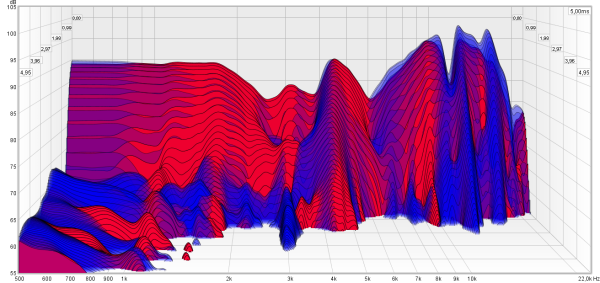
The CSD does not show any resonances that may be problematic. The dip around 3.5kHz is quite obvious. Around 4kHz there is a short lived resonance so it looks like the driver may have some break-up problems.
The spectrum plot below (left channel) also shows a well damped driver. Perhaps around 3kHz some small lingering but at this frequency the hearing has a resonance of its own so won’t be audible.
Below the impulse response of the (left, right)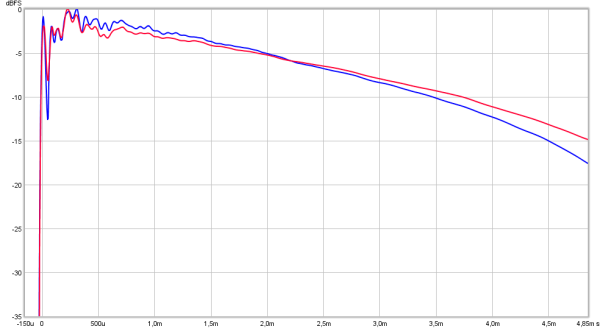 It shows the leading edge reaches the same level as the mids (200μs to 1ms) so the tonal balance for impulse response is quite good. The 2dB ‘peak’ (250-300μs) shows the 4kHz resonance is a bit more audible than the frequency plot shows.
It shows the leading edge reaches the same level as the mids (200μs to 1ms) so the tonal balance for impulse response is quite good. The 2dB ‘peak’ (250-300μs) shows the 4kHz resonance is a bit more audible than the frequency plot shows.
what’s inside
The baffle and driver is the same one as used in the closed Roland RH-300.
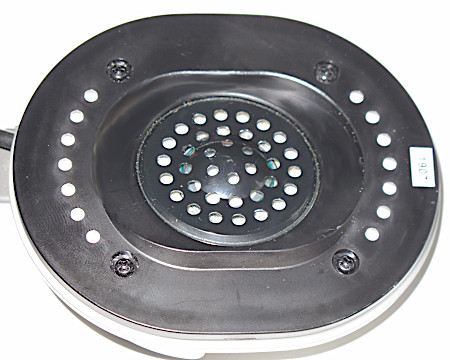 On the inside and on the rear side of the enclosure there are differences.
On the inside and on the rear side of the enclosure there are differences.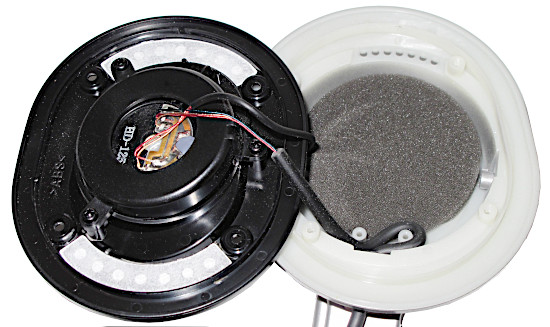 The cup is open and has some foam covering the holes. This is to prevent dust from getting in and adds a little acoustic resistance as well.
The cup is open and has some foam covering the holes. This is to prevent dust from getting in and adds a little acoustic resistance as well.
The driver (HD-125) and the baffle it is mounted on is the same as the one used in the RH-300 with the only difference being the RH300 has some foam directly behind the driver and a closed cup.
The driver looks a lot like the one that is used in the ATH-M50(X).
treble peak
The treble peak can be lowered a bit which improves on the ‘sharpness’.
This is easily done using a single ply of a 3-ply piece of toilet paper which goes between the driver and the dust screen from the pads.
Stock, 1 ply of toilet paper, 2 plies of toilet paper.
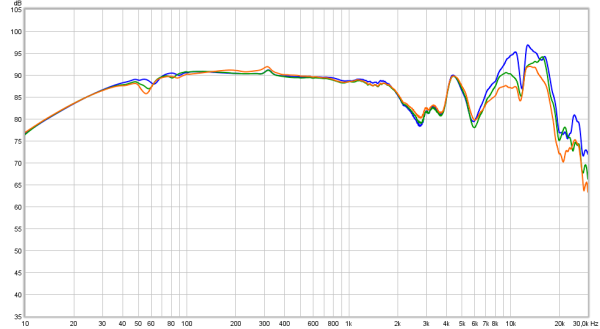
One could also experiment with felt between the driver and dust guard which has a similar effect and is easier to use as a single ply of toilet paper is very thin and tears easily. The toilet paper can be secured with some cellotape to its edges.
The toilet paper can be secured with some cellotape to its edges.
conclusion
The RH-A30 is a decent headphone with good tonality. At € 160.- it isn’t exactly cheap nor on the expensive side. Can be used well for monitoring and maybe even checking mixes.
The sensitivity is high, the impedance is neither too low nor too high, a higher output resistance does not result in a different tonality so can be used with almost any source.
For music enjoyment it is lacking a bit in treble quality and has some sharpness.
That can be improved a little with toilet paper or some felt. The treble quality (those looking for smooth silky highs) might be a little disappointed.
People with bigger ears should look elsewhere.
Positives:
- build quality
- cable low in microphonics and not heavy nor flimsy yet supple
- high efficiency (can be easily driven by phones etc.)
- 6.3 + 3.5mm TRS jack
- Tonal balance is quite neutral (realistic)
- high power rating so hard to blow up when it is lying on a desk while playing loud.
Less positive:
- cable length (3.5meter)
- treble/detailing is somewhat less
- can have some sharpness with certain recordings
- not much room for the ears

Quick question, would the measured 2-3k dip on these Roland headphones not be as percieved due to the concha gain from the angled drivers? I remember using these a couple years back and found them pretty forward sounding.
The 2-3 kHz range is not caused by the concha (that works higher up) but rather the ear-canal gain (resonance).
That differs from person to person. It turns out most people prefer a little less energy in that region (more ‘relaxed’ sound) and do not hear it as a lack of brightness.